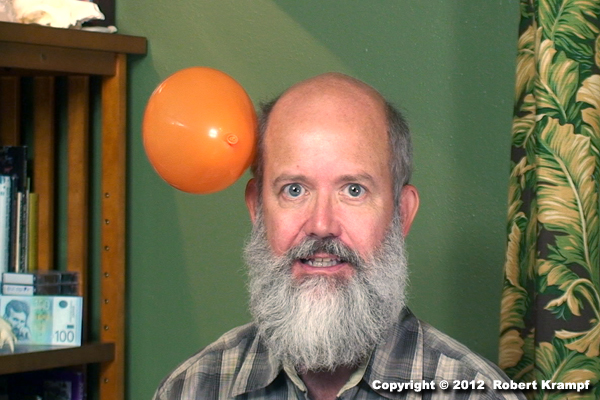
After I rubbed this ballon against my hair, it stuck to the side of my head. Why?
-
The balloon stuck because I don't have enough hair.
No. While much of my hair is gone, I still have enough to do this experiment. -
The balloon stuck because the balloon had the same charge as my hair.
No. Two things with the same electrostatic charge will repel, pushing apart. -
The balloon stuck because the balloon had a different charge from my hair.
Yes. When I rubbed the balloon against my hair, electrons moved from my hair to the balloon. The extra electrons gave the balloon a negative charge, and the missing electrons left my hair with a positive charge. Opposite charges attract, so the balloon stuck to my hair. -
The balloon stuck because my hair was magnetized.
No. Rubbing a balloon against something does not magnetize it. Even if it was magnetized, a magnet would not attract the rubber balloon.
Click to see which state standards this question tests, and which of my videos, experiments, and other resources support that topic.
Florida
SC.5.P.10.3 Investigate and explain that an electrically-charged object can attract an uncharged object and can either attract or repel another charged object without any contact between the objects.
>>> Teacher Page: Electrostatic Charges
| Electrostatics and Water | video, ClosedCaptions, checked |
| Challenge: Paper, Coin, Cup, part 2 | video |
| Sorting Salt and Pepper | video, checked |
| Electricity | video, free, Updated |
| Making Water Wiggle | video |
| Challenge: Paper, Coin, Cup, part 1 | video |
| Electrostatic Charges | video |
| The Leyden Jar | video, checked |
| Versorium | video, checked |
| Review Energy-6 | quest |
| Review Energy-7 | quest |
| Review Energy-8 | quest |
SC.6.P.13.1 Investigate and describe types of forces including contact forces and forces acting at a distance, such as electrical, magnetic, and gravitational.
| Water in a Glass, part 2 | video, checked |
| Water in a Glass, part 3 | video, checked |
| Water in a Glass, part 1 | video, checked |
| Challenge: Paper, Coin, Cup, part 2 | video |
| Light a Bulb with a Balloon | video, checked |
| Crushed Can | video, checked |
| Electricity | video, free, Updated |
| The Compass and Magnetic Fields | video, ClosedCaptions, checked |
| Challenge: Paper, Coin, Cup, part 1 | video |
| Making a Compass | video, checked |
| Torque | video |
| Versorium | video, checked |
| Review Energy-6 | quest |
| Review Energy-7 | quest |
| Review Energy-8 | quest |
Utah
UT.5.IV.1.c Describe the behavior of objects charged with static electricity in attracting or repelling without touching.
| Electrostatics and Water | video, ClosedCaptions, checked |
| Challenge: Paper, Coin, Cup, part 2 | video |
| Sorting Salt and Pepper | video, checked |
| Making Water Wiggle | video |
| Challenge: Paper, Coin, Cup, part 1 | video |
| Electrostatic Charges | video |
| The Leyden Jar | video, checked |
| Versorium | video, checked |
| Review Energy-6 | quest |
| Review Energy-7 | quest |
NGSS
MS-PS3-2 Develop a model to describe that when the arrangement of objects interacting at a distance changes, different amounts of potential energy are stored in the system.
| Versorium | video, checked |
| Water in a Glass, part 2 | video, checked |
| Water in a Glass, part 3 | video, checked |
| Water in a Glass, part 1 | video, checked |
| Electrostatics and Water | video, ClosedCaptions, checked |
| Challenge: Paper, Coin, Cup, part 2 | video |
| Sorting Salt and Pepper | video, checked |
| Making Water Wiggle | video |
| Measuring Kinetic and Potential Energy | video, checked |
| Challenge: Paper, Coin, Cup, part 1 | video |
| The Leyden Jar | video, checked |
| Review Energy-6 | quest |
| Review Energy-7 | quest |
| Review Energy-8 | quest |
